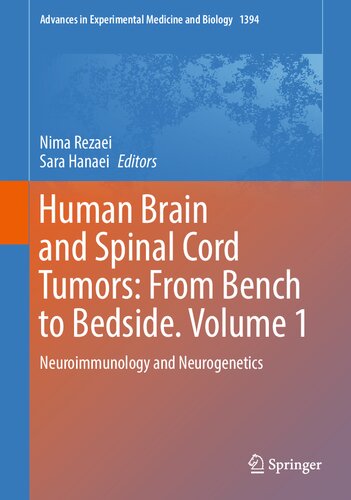Human Brain and Spinal Cord Tumors: From Bench to Bedside. Volume 1: Neuroimmunology and Neurogenetics 2023
دانلود کتاب پزشکی تومورهای مغز و نخاع انسان: از نیمکت تا تخت جلد 1: نوروایمونولوژی و نوروژنتیک
| نویسنده |
Nima Rezaei, Sara Hanaei |
|---|
| تعداد صفحهها |
231 |
|---|---|
| نوع فایل |
|
| حجم |
6 Mb |
| سال انتشار |
2023 |
89,000 تومان
تومورهای مغزی تقریباً 5-9٪ از کل تومورهای انسانی را تشکیل می دهند. جالب توجه است که تومورهای سیستم عصبی مرکزی (CNS) در میان شایع ترین تومورها در دوران کودکی نیز قرار دارند. علاوه بر ویژگی های مورفولوژیکی و هیستوپاتولوژیک، و از آنجایی که هر وضعیت پاتولوژیک ابتدا با تغییرات مولکولی شروع می شود، هر تومور ممکن است داستان خاص خود را در زمینه فعال شدن مسیرهای تومورزایی داشته باشد و ویژگی های مولکولی خاصی داشته باشد. نکته مهم، طبقه بندی مولکولی تومورها در چند دهه گذشته برای مناسب ترین رویکرد درمانی مورد توجه قرار گرفته است. از سوی دیگر، تومورها باید مکانیسمهایی در مقیاس تومور داشته باشند که از ریشهکن کردن تهاجم سیستم ایمنی جلوگیری کند. بنابراین شکست سیستم ایمنی ذاتی و اکتسابی در شکست مکانیسم های تومورزایی منجر به توسعه تومور می شود. جالب اینجاست که مکانیسم عصبی ایمنی در ایجاد تظاهرات روانپزشکی تومورهای مغزی نیز نقش دارد. با در نظر گرفتن همه این موارد، بازوهای مختلف ایمنی ذاتی، ایمنی تطبیقی و ژنتیک برای شکست دادن توسعه و/یا پیشرفت چنین تومورهایی مورد بررسی قرار گرفتهاند. بر این اساس، رویکردهای ایمونوتراپی فعالسازی بر فعال کردن یا تقویت مسیرهای ایمنی ضد تومور به منظور کمک به سیستم ایمنی ضعیف شده برای شکست تومور (مانند واکسنهای سلول دندریتیک، واکسنهای DNA، واکسنهای پپتیدی، واکسنهای مبتنی بر ناقل ویروسی، آنتیبادیهای مونوکلونال، درمان با CAR T تمرکز میکنند. سلول ها). علاوه بر اجزای ایمونولوژیک تومورهای مغز و نخاع، چندین ژن و مسیرهای ژنتیکی نیز شناسایی شده اند که در تومورزایی نقش دارند. با در نظر گرفتن این مسیرهای ژنتیکی غیرایمنی، برخی از رویکردهای درمانی دیگر مانند درمان با سلول های بنیادی و ژن درمانی در دوره جدید درمان سرطان توسعه یافته اند. علاوه بر این، علاوه بر جنبههای بیولوژیکی و پزشکی این تومورها، مدلهای فیزیکی/ریاضی مختلفی برای توضیح یا پیشبینی رفتار تومور پیشنهاد شدهاند. چنین مدل هایی ممکن است در توسعه رویکردهای درمانی جدید در مراحل پیش بالینی و آغاز دوره های جدید در درمان سرطان مفید باشند.
اولین کتاب در مورد تومورهای مغز و نخاع انسان، ایمنی عصبی، و نوروژنتیک در درجه اول به بحث در مورد نوروایمونولوژی و مسیرهای نوروژنتیکی درگیر در توسعه تومورهای مغز و نخاع می پردازد. پس از یک فصل مقدمه کوتاه، این کتاب به نقش ایمنی ذاتی و تطبیقی در ایجاد این تومورها و سپس رویکردهای ایمونوتراپی برای شکست این مکانیسمهای سرطانزا میپردازد. سپس این کتاب بر جنبههای ژنتیکی تومورهای مغز و نخاع و مدلهای بیوانفورماتیک برای توصیف الگوهای رفتاری این تومورها و همچنین رویکردهای درمانی مرتبط مانند درمان با سلولهای بنیادی و ژن درمانی تمرکز خواهد کرد. این کتاب میتواند برای متخصصان علوم پایه، بهویژه متخصصان ژنتیک و ایمونولوژیستها، و همچنین پزشکان متخصصان مختلف، در درجه اول جراحان مغز و اعصاب، متخصصان مغز و اعصاب، آسیبشناسان عصبی و رادیولوژیستهای عصبی مفید باشد.
Brain tumors comprise about 5–9% of all human neoplasms; and interestingly the central nervous system (CNS) neoplasms are ranked among the most prevalent neoplasms of childhood as well. Besides to the morphologic and histopathologic characteristics, and as each pathologic states first starts with molecular alterations, each tumor may have its own story in the matter of activating tumorigenesis pathways and having specific molecular characteristics. Importantly, the molecular classification of tumors has been highly considered in the past few decades for taking the most appropriate therapeutic approach. On the other hand, the tumors shall have tumor-scape mechanisms preventing the immunologic system to eliminate its invasion. The failure of innate and acquired immune system to defeat tumorigenesis mechanisms would consequently result in tumor development. Interestingly, the neuro-immunologic mechanism plays a role in development of psychiatric manifestations of brain tumors as well. Taking all these to account, the different arms of innate immunity, acquired immunity, and genetics have been approached to defeat development and/or progression of such tumors. Accordingly, the activation immunotherapeutic approaches focus on activating or strengthening the anti-tumor immunologic pathways in order to assist the weakened immune system to defeat the tumor (such as Dendritic cell vaccination, DNA vaccines, peptide vaccines, viral vector-based vaccines, monoclonal antibodies, and CAR T-cell therapy). In addition to immunologic components of brain and spinal cord tumors, numerous genes and genetic pathways have been recognized to take part in tumorigenesis. Taking these non-immune genetic pathways to account, some other therapeutic approaches such as stem cell therapy and gene therapy have been developed in the new era of cancer treatment. Moreover, and besides the biologic and medical aspects of these tumors, different physical/mathematical models have been proposed to either explain or predict tumor behavior. Such models would be advantageous in developing new therapeutic modalities in pre-clinical stages and enter new eras in cancer treatment.
The first book of Human Brain and Spinal Cord Tumors, Neuro-immunology and Neuro-genetics, will mainly discuss the neuro-immunology and neurogenetic pathways associated with development of brain and spinal cord tumor. After a short introduction chapter, this book will focus on the role of innate and acquired immunity on development of these tumors and then the immunotherapeutic approaches to defeat these tumorigenesis mechanisms. This book will then focus on genetic aspects of brain and spinal cord tumors and bioinformatics models to describe the behavioral patterns of these tumors, as well as associated therapeutic approaches such as stem cell therapy and gene therapy. This volume of book could be useful for experts in basic sciences, mainly geneticists and immunologists, and also physicians of different specialties, mainly neurosurgeons, neurologists, neuropathologists and neuroradiologists.




